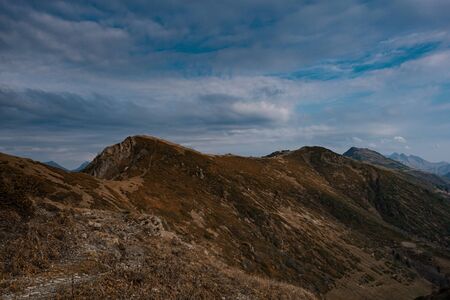Introduction to the West Highland Way
The West Highland Way is more than just a walking route—it is a rite of passage for outdoor enthusiasts and a cherished part of Scotland’s cultural landscape. Stretching 96 miles (154 kilometres) from Milngavie, just outside Glasgow, to the iconic highland hub of Fort William, this legendary trail traverses some of the most breathtaking scenery in the British Isles. First opened in 1980 as Scotland’s inaugural official long-distance footpath, the West Highland Way quickly became a favourite among both local ramblers and international visitors alike. Its path weaves through rolling lowland pastures, alongside shimmering lochs, across ancient woodlands, and into the dramatic peaks of the Scottish Highlands.
The history of the West Highland Way is deeply entwined with Scotland’s past. The route follows old drovers’ roads, military tracks built during the Jacobite uprisings, and traditional coaching routes that have witnessed centuries of movement, trade, and conflict. Today, hikers follow in the footsteps of cattlemen, clansmen, and soldiers—each step echoing with stories from Scotland’s rich heritage.
What makes the West Highland Way so beloved? It is not just the scenery—though that alone would be reason enough—but also the sense of adventure and connection it fosters. The walk offers a unique blend of challenge and accessibility; whether you’re an experienced hillwalker or a first-time long-distance trekker, there are sections suited to every ability. Add to this the warmth of Scottish hospitality found in villages along the way, and it’s easy to see why thousands return year after year. For many, completing the West Highland Way is not simply a walk—it’s a journey through history, community, and some of Scotland’s finest natural beauty.
2. Planning Your Adventure
Tackling the West Highland Way is a quintessentially Scottish experience, but thoughtful preparation is key to enjoying the journey safely and comfortably. In this section, we’ll cover vital aspects of planning, from picking the ideal time to go, to route choices and the all-important logistics, with practical advice especially for UK-based walkers.
Choosing the Best Time to Walk
Scotland’s weather is notoriously changeable, so timing your walk makes a big difference. The most popular months are late spring through early autumn (May–September), when daylight hours are longest and temperatures mild. However, each season has its quirks:
| Season | Pros | Cons |
|---|---|---|
| Spring (April–May) | Wildflowers in bloom, fewer midges, quieter trails | Unpredictable showers, lingering snow on higher ground |
| Summer (June–August) | Longest days, warmest weather | Busy trails, midges at their worst |
| Autumn (September–October) | Stunning foliage, fewer crowds | Cooler temperatures, shorter days |
Essential Preparation Tips
- Fitness Training: Prepare with regular walks—aim for hilly routes to build stamina.
- Gear Check: Invest in sturdy boots and waterproofs; Scottish rain is legendary.
- Packing Smart: Keep it light but don’t skimp on essentials like layers, first aid kit, and snacks.
Route Planning & Distances
The West Highland Way stretches 96 miles (154 km) from Milngavie to Fort William. Most walkers take 6-8 days to complete it. Here’s a sample breakdown:
| Section | Miles (km) |
|---|---|
| Milngavie to Drymen | 12 (19) |
| Drymen to Rowardennan | 14 (22) |
| Rowardennan to Inverarnan | 14 (22) |
| Inverarnan to Tyndrum | 12 (19) |
| Tyndrum to Kingshouse | 19 (30) |
| Kingshouse to Kinlochleven | 9 (14) |
| Kinlochleven to Fort William | 15 (24) |
Baggage Transfer Services
If you’d rather not carry all your kit, several local companies offer baggage transfer services—ideal for UK walkers wanting a lighter load each day. Book these well ahead in peak season.
Travel Logistics: Getting There & Away
- Start Point: Milngavie is easily reached by train from Glasgow Central or Queen Street stations.
- Finish Point: Fort William has rail links southbound to Glasgow and northward towards Mallaig.
- Luggage & Accommodation: Book accommodation early—especially during school holidays—and check cancellation policies.
- Navigation: While the route is well signposted, carrying an OS map or GPS device is sensible backup.
A successful West Highland Way adventure hinges on smart planning. With realistic expectations and attention to logistics, you’ll be well set for one of Scotland’s classic walking experiences.

3. Navigating the Route
The West Highland Way stretches for 96 miles (154 kilometres) from Milngavie, just outside Glasgow, to Fort William in the heart of the Highlands. This iconic trail is typically divided into several sections, each offering a distinct taste of Scotland’s landscapes and heritage.
Milngavie to Drymen
Your journey begins in the welcoming suburb of Milngavie. The initial stretch winds through parkland and gentle countryside, passing Mugdock Country Park and the charming Blanefield village. Keep an eye out for stone waymarkers that reassure you you’re on the right path.
Drymen to Balmaha
This section takes you over Conic Hill, providing your first real climb and panoramic views across Loch Lomond. Balmaha is a popular stopping point, where you can reward yourself with a cuppa at the local inn or explore the Tom Weir statue—a nod to a beloved Scottish outdoorsman.
Balmaha to Rowardennan
The trail hugs the eastern shores of Loch Lomond, meandering through ancient woodlands. You’ll pass Rob Roy’s Cave, steeped in Highland legend. Rowardennan offers both rustic hostels and classic Scottish hospitality at its hotel bar—ideal for sampling a dram of whisky.
Rowardennan to Inverarnan
This rugged section features twisting paths, pebble beaches, and dense forest. It’s also one of the most demanding segments but rewards with wild beauty and sightings of red deer. The Drovers Inn at Inverarnan is an institution—don’t miss its ghostly tales and hearty meals.
Inverarnan to Tyndrum
The scenery opens up as you enter Glen Falloch and pass cascading waterfalls. Crianlarich serves as a crossroads for hikers; pop into the village shop for local treats. Beyond here, you’ll find reminders of Scotland’s railway heritage before reaching Tyndrum.
Tyndrum to Kingshouse
This is classic Highland territory: sweeping moorland, distant peaks, and the evocative Bridge of Orchy. Rannoch Moor is hauntingly beautiful—often misty and atmospheric. Kingshouse Hotel is a legendary stop, renowned for its mountain views and friendly walkers’ bar.
Kingshouse to Fort William
The final stretch includes the Devil’s Staircase—a winding ascent rewarded by spectacular vistas towards Ben Nevis. Descend into Kinlochleven before following old military roads through lush glens. As you approach Fort William under the gaze of Ben Nevis, take pride in completing a true Scottish rite of passage.
4. What to Pack and Wear
When it comes to hiking the West Highland Way, packing smart is essential. Scotland’s weather is famously unpredictable—think sunshine, rain showers, and gusty winds all in a single day. The rugged terrain of the Highlands also demands durable kit. Below, you’ll find practical recommendations tailored for UK walkers, with a nod to trusted local outdoor gear brands that can stand up to the challenge.
Layering: Your First Line of Defence
The secret to staying comfortable on the trail is layering. You’ll want a moisture-wicking base layer, an insulating mid-layer, and a fully waterproof outer shell. For the best performance, look for brands like Rab (Sheffield-based), Montane (Northumberland), and Berghaus (Sunderland), which are renowned across Britain for their technical expertise.
Essential Clothing Kit List
| Item | Recommendation | UK Brand Example |
|---|---|---|
| Base Layer (top & bottoms) | Synthetic or merino wool for wicking | Rab Merino+ 120 LS Tee |
| Mid Layer (fleece or light insulated jacket) | Lightweight fleece or synthetic fill | Montane Protium Fleece |
| Waterproof Jacket & Trousers | Breathtable, fully seam-sealed | Berghaus Paclite Shell Jacket & Overtrousers |
| Trekking Trousers | Quick-drying, flexible fabric | Craghoppers Kiwi Pro Stretch Trousers |
| Walking Socks (multiple pairs) | Cushioned, anti-blister design | Darn Tough UK Edition / Bridgedale Hike Midweight Boot Socks |
| Hat & Gloves | Warm but packable; consider windproof options | Rab Power Stretch Beanie & Montane Prism Gloves |
| Gaiters (optional) | For boggy or wet sections | Trekmates Cairngorm Gaiter |
Footwear: Invest Wisely for the Highlands
The terrain along the West Highland Way varies from tarmac lanes to rocky ascents and muddy moorland. A sturdy pair of broken-in walking boots with ankle support is non-negotiable. Scarpa and Meindl both have excellent reputations among British hikers. Don’t forget a pair of lightweight trainers or sandals for evenings at your accommodation.
Packing Essentials Beyond Clothing
| Item | Description/Tip | UK Brand Example |
|---|---|---|
| Backpack (35-50L) | Padded hip belt & rain cover recommended | Lowe Alpine AirZone Trail ND33:40 |
| Water Bottle/Hydration System | 2L minimum capacity; streams are common but not always safe to drink from untreated | Lifesystems Water Purification Tablets/LifeStraw Go |
| Trekking Poles | Aids stability on steep or uneven ground | Pole Trekker Carbon Compact Poles |
| First Aid Kit | Packed with plasters, blister pads, pain relief | Lifesystems Mountain First Aid Kit |
A Note on Midge Protection and Other Comforts
If you’re walking between May and September, don’t underestimate the infamous Scottish midge. Pack Smidge or Avon Skin So Soft as repellent, and consider a head net if you’re particularly sensitive. Bring a lightweight sit mat for breaks, sunscreen even on overcast days, and a power bank for keeping your devices charged in remote areas.
Packing well means you’ll be prepared for anything the West Highland Way can throw at you—rainbows or rainstorms alike—and makes all the difference in enjoying this classic Scottish adventure.
5. Where to Stay and Eat Along the Way
One of the joys of hiking the West Highland Way is experiencing authentic Scottish hospitality and traditional fare. Whether you’re after a rustic experience or a comfortable bed, there’s something for everyone along this storied route.
Bothies: The Wild Camper’s Haven
If you crave adventure and simplicity, bothies offer a truly unique way to spend the night. Scattered in remote locations along the trail, these basic shelters are free to use and maintained by volunteers. There’s no electricity or running water, so come prepared with your own supplies and respect the “leave no trace” principle. Bothies are ideal for those looking to immerse themselves in Scotland’s wild landscape and connect with fellow hikers over stories by candlelight.
B&Bs: Scottish Warmth and Comfort
For those preferring home comforts, Bed & Breakfasts (B&Bs) are plentiful in villages such as Drymen, Tyndrum, and Kinlochleven. Expect a warm welcome from local hosts, a comfy bed, and—of course—a hearty Scottish breakfast to set you up for the day. Many B&Bs offer packed lunches on request, perfect for refuelling on the go. Booking ahead is advisable, especially during peak season, as these spots fill up quickly with walkers from around the world.
Hostels and Inns: Sociable Stops
Hostels and traditional inns are great options for those seeking sociable atmospheres and affordable rates. The communal kitchens in hostels allow you to prepare your own meals if you fancy a break from pub grub, while inns often feature lively bars where you can sample local ales and meet fellow adventurers. Don’t miss out on the chance to share stories over a pint of real ale at one of the many historic inns dotted along the route.
Hearty Scottish Grub: What to Eat on the Trail
No West Highland Way journey would be complete without sampling some classic Scottish dishes. Fuel up on robust breakfasts featuring black pudding, tattie scones, and haggis. Pubs along the way serve warming plates like Cullen skink (smoked haddock soup), steak pie, or venison casserole—perfect after a long day’s walk. For something sweet, try sticky toffee pudding or cranachan made with local raspberries and whisky-laced cream.
Top Tips for Food & Accommodation
- Book popular B&Bs early—especially in summer.
- If staying in bothies, always carry enough food, water purification tablets, and a sleeping bag.
- Packed lunches from B&Bs or village shops can save time and keep you fuelled between stops.
- Vegetarian options are widely available but do check ahead if you have specific dietary requirements.
Final Thought
Whether it’s sharing whisky in a mountain bothy or tucking into comfort food at a cosy inn, eating and sleeping well is all part of the West Highland Way adventure. Embrace Scotland’s renowned hospitality—you’ll be talking about these experiences long after your boots have dried!
6. Safety, Etiquette and Practical Tips
Responsible Hiking on the West Highland Way
The West Highland Way traverses some of Scotland’s most cherished landscapes, and with that privilege comes responsibility. Walkers are urged to follow the Scottish Outdoor Access Code, which means respecting the land, wildlife, and fellow users. Stick to marked paths where possible to minimise erosion and avoid disturbing livestock by closing gates behind you. Wild camping is permitted under Scottish law, but it is crucial to leave no trace: take all litter with you, camp away from buildings and roads, and keep groups small.
Trail Etiquette Unique to Scotland
Scottish trails are shared spaces, frequented by locals and visitors alike. A friendly “hello” or nod when passing others is customary. If you encounter slower walkers or cyclists, pass considerately on the left, giving plenty of space. In rural areas, be mindful of farmers at work—if you must cross fields with livestock, move quietly and avoid separating animals from their young. Dogs should always be kept under close control or on a lead during lambing season.
Health and Safety Considerations
The Scottish weather is famously unpredictable—sunshine can swiftly give way to rain or mist even in summer months. Always carry waterproofs, extra layers, and a hat regardless of the forecast. Mobile phone signal can be patchy along stretches of the Way; let someone know your plans before setting out each day and consider carrying a power bank for emergencies. Sturdy walking boots are essential for uneven terrain, and blister plasters are worth their weight in gold.
Environmental Awareness
Respect the fragile ecosystem by avoiding damage to flora and fauna—never pick wildflowers or disturb nesting birds. Use designated toilet facilities where available; if nature calls elsewhere, bury waste well away from watercourses. Fires are discouraged due to risk of wildfires; use a stove instead if cooking outdoors. By observing these guidelines, hikers play their part in preserving the West Highland Way for future generations.
7. Finishing and What to Do Next
Celebrating Your Achievement at Fort William
Reaching the end of the West Highland Way at Fort William is a moment to savour. The finishing marker by the high street is a rite of passage—don’t be shy about asking a fellow walker for a photo, or treating yourself to a well-earned dram in one of the local pubs. Many hikers gather at the Grog & Gruel or the Ben Nevis Inn to swap stories and share laughs over hearty Scottish fare. Take time to wander through the town, browse independent shops, and soak up the mountain views—after all, you’ve just completed one of Scotland’s most iconic long-distance walks.
Ideas for Further Scottish Adventures
If your legs are still itching for adventure, Fort William is perfectly placed as a gateway to more outdoor pursuits. Why not consider climbing Ben Nevis, the UK’s highest peak? Alternatively, explore Glen Nevis for gentler walks or hop on the Jacobite Steam Train for a scenic journey towards Mallaig. For those keen to continue walking, the Great Glen Way begins right here and traces another dramatic route northwards towards Inverness. Scotland’s wild beauty is addictive—there’s always another loch, glen, or munro waiting for you.
Ways to Reflect and Share Your Experience
Once you’ve caught your breath, take time to reflect on your journey. Jot down your thoughts in a journal or start compiling photos for an album. Sharing your experience—whether through social media, blog posts, or even a talk at your local ramblers’ group—can help preserve those memories and inspire others to follow in your footsteps. Consider leaving a review for accommodations or services you appreciated along the way; it’s a small gesture that supports local businesses and future walkers alike. Most importantly, give yourself credit: completing the West Highland Way is no mean feat, and you now join a proud tradition of hikers who’ve traversed Scotland’s legendary landscapes.


